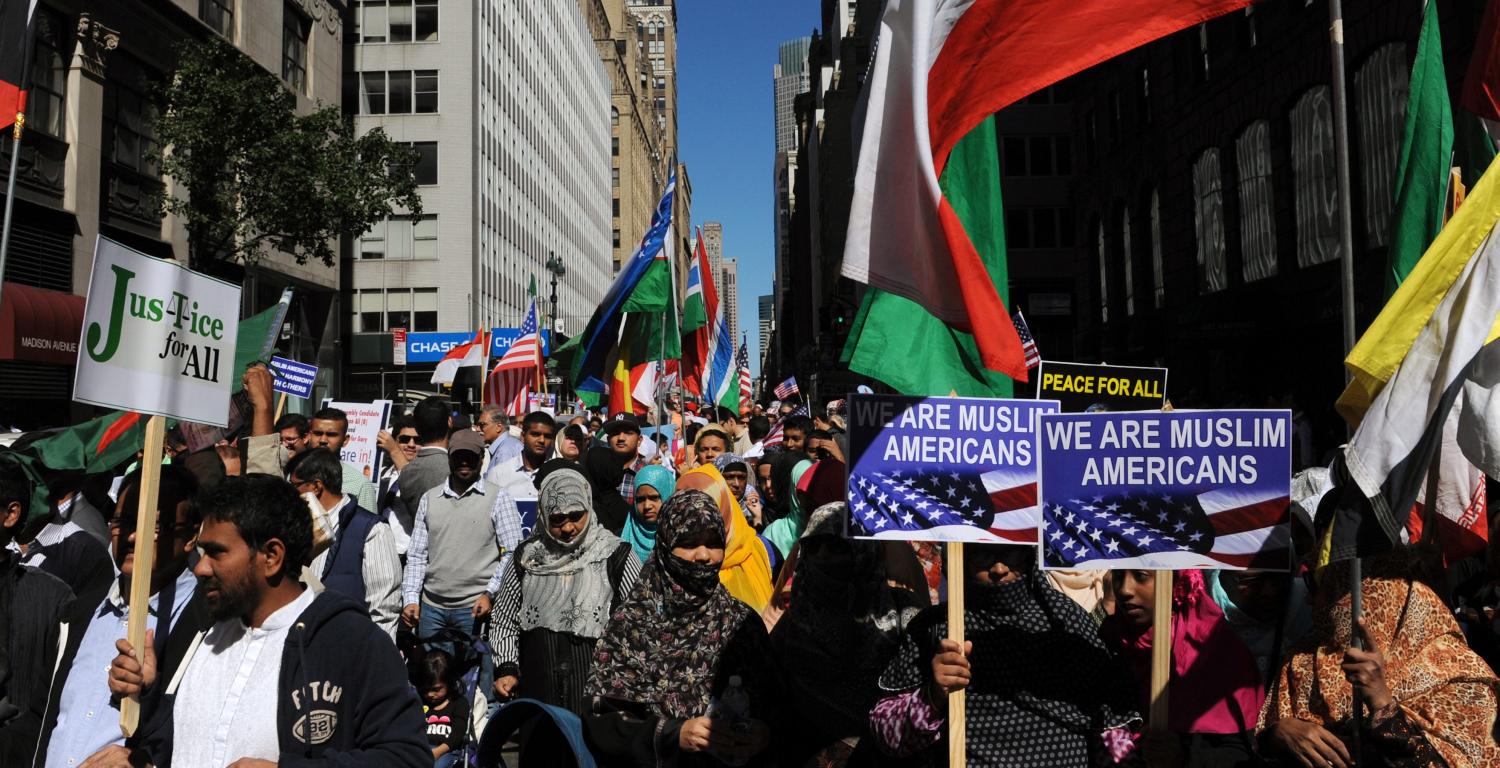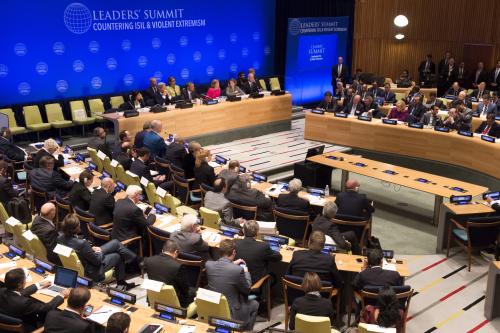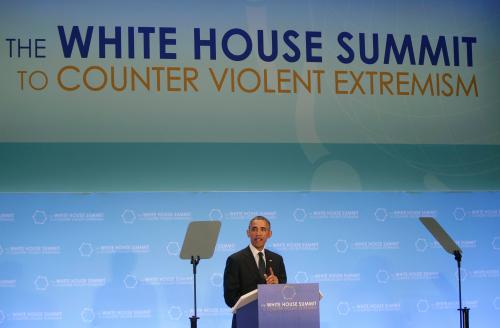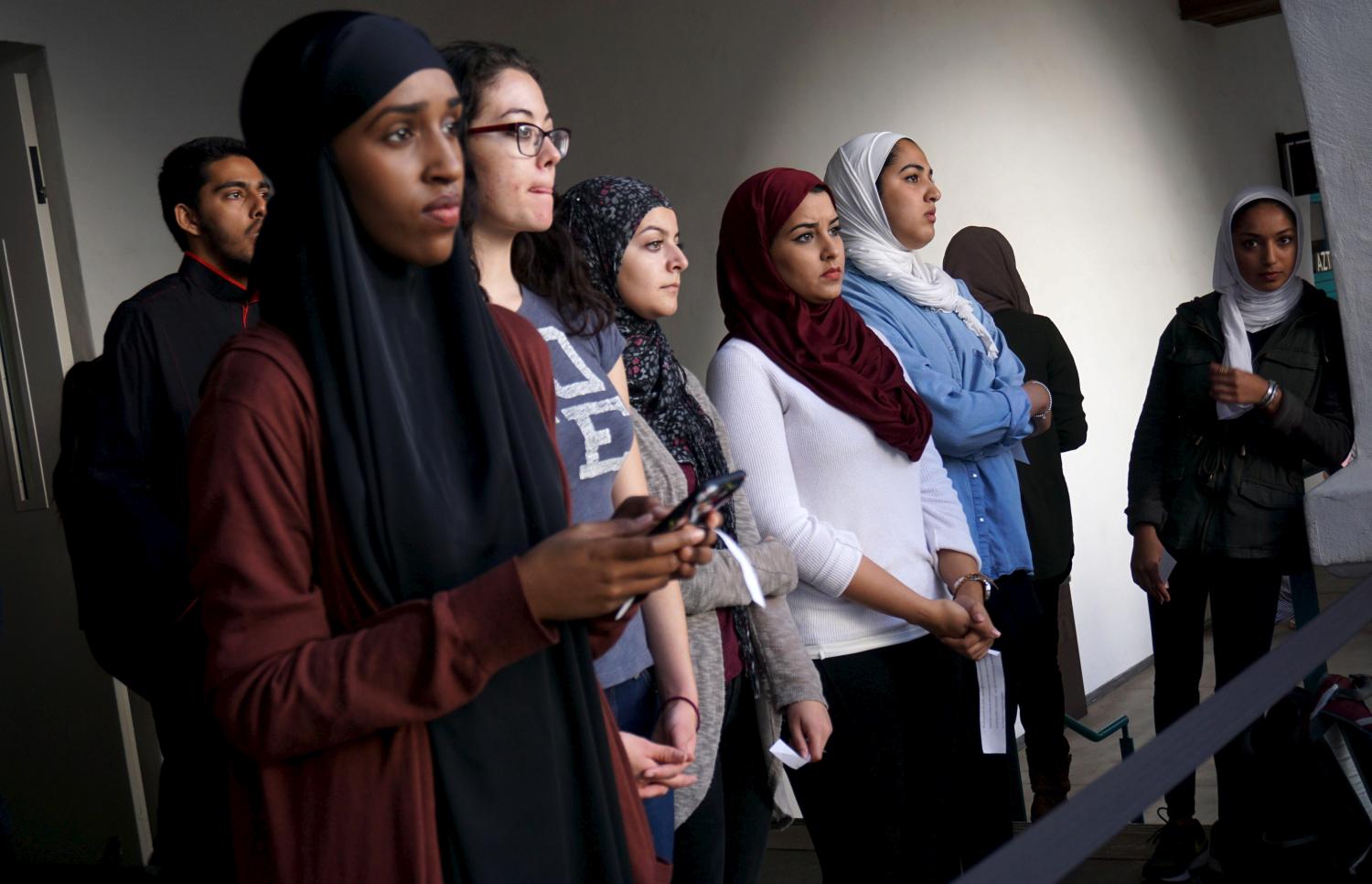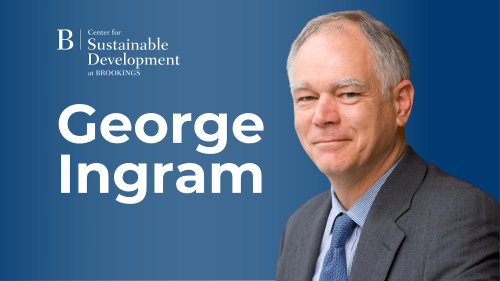The following brief is part of Brookings Big Ideas for America—an institution-wide initiative in which Brookings scholars have identified the biggest issues facing the country and provide ideas for how to address them. (Updated January 27, 2017)
 To combat the enduring appeal of Salafi jihadism, the U.S. government and its allies have devoted an enormous amount of time, energy, and resources to counter violent extremism (CVE). At the UN General Assembly in September 2014, President Obama called on nations to do more to counter violent extremism, and in February 2015 he convened a White House summit on the topic.1 There is a CVE Task Force hosted by the Department of Homeland Security and co-led with the Department of Justice.2 Following bipartisan congressional support for the CVE Act of 2015,3 a new CVE office was established at the Department of Homeland Security. At the Department of State, the Bureau of Counterterrorism was renamed the Bureau of Counterterrorism and Countering Violent Extremism. Additionally, there have been several important multilateral and international initiatives, such as the Global Counterterrorism Forum and the Hedayah Center in Abu Dhabi.4
To combat the enduring appeal of Salafi jihadism, the U.S. government and its allies have devoted an enormous amount of time, energy, and resources to counter violent extremism (CVE). At the UN General Assembly in September 2014, President Obama called on nations to do more to counter violent extremism, and in February 2015 he convened a White House summit on the topic.1 There is a CVE Task Force hosted by the Department of Homeland Security and co-led with the Department of Justice.2 Following bipartisan congressional support for the CVE Act of 2015,3 a new CVE office was established at the Department of Homeland Security. At the Department of State, the Bureau of Counterterrorism was renamed the Bureau of Counterterrorism and Countering Violent Extremism. Additionally, there have been several important multilateral and international initiatives, such as the Global Counterterrorism Forum and the Hedayah Center in Abu Dhabi.4
Yet despite CVE’s ascendancy as a policy paradigm, two significant and interrelated problems continue to confound practitioners and policymakers. The next president will need to address them.
The first concerns the lack of empirical knowledge about the root causes and drivers of violent extremism. This lacuna has led to conceptual confusion about CVE. It is difficult to design an effective policy when there is little consensus on what it means to counter violent extremism or what actions might be taken to do so. Consequently, CVE efforts are mostly designed and funded on the basis of anecdotal evidence, with unknown results.
Second, the Obama administration’s domestic CVE policy has strained relations with an entire religious community, in large part because its policy perceives American Muslims through a security lens. The Department of Justice has led domestic CVE efforts, which primarily consist of outreach to Muslim leaders to keep the community involved and encourage information sharing about vulnerable youth. But the community rarely knows about youth who are radicalized in their midst. Moreover, the vast majority of Muslims do not embrace violent extremism, especially in America. Of the world’s jihadi foreign fighter population, approximately 250 people5 out of 3.3 million Muslims6 in America (a mere .0075 percent) have been mobilized,7 compared with 1,700 out of 4.7 million Muslims in France (.036 percent), and 6,000 out of 11 million in Tunisia (.054 percent).8 What is more, the scale, scope, and complexity of the problem vary significantly by location. For example, two neighborhoods in Brussels have produced nearly two-and-a-half times as many foreign fighters as all of America, even though America has more than five times as many Muslims as Belgium does.9
[A]n alienating CVE agenda could in fact create the very problem it sets out to solve.
This is not to suggest that there is no threat from Salafi violent extremism in the United States. Rather, it is neither the only nor by far the greatest threat to the country and its interests. It should go without saying that alienating an entire religious community undermines American principles and values. Worse yet, this alienation itself could very well spur radicalization, thereby undermining not only our principles and values but also our security. Therefore, it is not inconceivable that an alienating CVE agenda could in fact create the very problem it sets out to solve.
Policy Proposals
he policy proposals below follow from the abovementioned observations.
Learn from past failures
CVE efforts in the United States have struggled. There have been three recent CVE pilot programs in Boston, Los Angeles, and Minneapolis,10 and each one has received widespread criticism from Muslim communities—the very communities that were intended as key partners. Many American Muslims feel that these programs securitized their relationship with the U.S. government. They point out that most Muslims who carry out or plot terrorist attacks are not active in their community, and almost none have been openly radicalized in social settings, such as at mosques or community centers. Most are radicalized online and in small cloistered groups, with limited contact with the wider community.
These points are not unfounded. Since 2014, 100 Americans have been charged in connection with the Islamic State and 43 have been convicted.11 These 43 individuals were living in different parts of the country. To cite those states with the most cases: New York has 18 cases (14 pending and four convictions); Minnesota has 12 cases (four pending and eight convictions); and Virginia has 10 cases (seven pending and three convictions). In New Jersey and Michigan—two states with areas with dense Muslim populations—they have had only four cases (zero pending and four convictions) and three cases (three pending and zero convictions), respectively. In other words, there is no clear nexus between a particular city, neighborhood, mosque, or community center and violent extremism in America. Yet, the current CVE agenda suggests otherwise.
End FBI and law enforcement outreach as a CVE activity
In addition to the pilot projects listed above, the FBI and local law enforcement routinely have held meetings with Muslim community leaders across the country. Between 2012 and 2015, the FBI and local law enforcement convened more than 2,500 engagement events.12 According to the Department of Justice, the aim is to “foster trust, improve awareness, and educate communities about violent risk factors in order to stop radicalization to violence before it starts.” However, this type of outreach is sowing distrust in Muslim communities about government activities.
A recurrent complaint is that the government does no such outreach to white nationalist and far-right-wing Americans, despite the fact that before the Orlando terrorist attack there were roughly the same number of domestic deaths as the result of terrorism by far-right wing individuals compared to Muslims since 9/11 (48 deaths versus 45 deaths, respectively; since Orlando, the numbers now stand at 50 deaths and 94 deaths, respectively).13 Muslims also point out that the number of jihadi terrorists pales in comparison to other criminal threats or leading causes of death in America. For example, there are 1.4 million gang members in America; in Chicago alone, there are 70 gangs, with 150,000 gang members.14 In 2014, there were nearly 31,000 alcohol-induced deaths, and over 33,000 people died from firearm injuries, with homicides accounting for 32.6 percent (homicide was the 17th leading cause of death).15
Citing these kinds of examples, Muslims are concerned they are being singled out and that law-enforcement-led community outreach is merely a ploy to use the soft tools of public diplomacy to support the hard tools of law enforcement investigations. Well-meaning and creative ideas to include such things as liaison officers—Muslims working with or for the FBI and law enforcement—will only add to the growing belief that the government is deputizing Muslims to help provide surveillance on and build cases against other Muslims. Community members lament that if the government were truly interested in learning about their concerns, then outreach and engagement efforts would be led by the Department of Health and Human Services, municipal authorities, and civil society, not by federal and local law enforcement.
To be clear, the FBI and local law enforcement should continue to engage Muslim religious, business, civic, and community leaders to maintain a network of contacts across the country. This allows for open lines of communications, which is vital for when there are problems and also helps demystify the important work of federal and local law enforcement. However, this type of engagement should be decoupled from CVE efforts. Otherwise, it will continue to strain relations with Muslims and reinforce the impression—rightly or wrongly—that the government views them writ large as a potential security problem.
Reorient domestic CVE efforts away from communities and towards individual interventions
The next president should refine and tighten the domestic CVE agenda so that, rather than a community-oriented approach targeting so-called “vulnerable communities,” it focuses squarely on individuals who have demonstrated sympathy for propaganda produced by foreign designated terrorist organizations. Such a focus should favor intervening with or rehabilitating these individuals, depending on three primary interrelated factors: (1) whether indicators such as social media usage suggest high likelihood of committing a crime, (2) whether they have already committed a crime, and (3) what type of crime they have committed.
Introduce nationwide intervention programs
The next president should introduce a nationwide intervention program that focuses on law-abiding citizens who have demonstrated a clear enthusiasm for violent extremism and/or terrorist organizations. Examples of such enthusiasm might include posting and/or promoting on social media “the virtues” of the Islamic State or al-Qaeda, or extolling the Islamic State, other terrorist groups, and/or related activities while in a public or social setting. The FBI has identified roughly 1,000 individuals as persons who have been radicalized online (and 80 percent by the Islamic State).16 This is a manageable number for such intervention programs.
The interventions should be limited to minors who can be legally required by their parents to attend rehabilitation and similar programs. As for adults, interventions should be limited to those who have committed nonviolent crimes. Each intervention should be tailored to the specific needs of the individual, in a manner similar to community drug courts that deal with addiction. The Department of Health and Human Services should have federal oversight, but programs must be designed, implemented, and led at the local level with direct input and support from a range of professionals and local actors, including community and family members. A hotline should be incorporated to allow individuals or families to seek guidance on how best to support someone heading down the wrong path. In order to build and deepen trust, this hotline should not serve law enforcement and intelligence purposes. However, clear guidance should be provided as to when and how the FBI and law enforcement should be engaged if there are concerns about criminal activity or terrorist plots. Lastly, the next administration will need to ensure that those supporting intervention programs are not exposed to financial or criminal liabilities. At present, nongovernment officials who are involved in interventions can be exposed to a range of liabilities for having provided material support to a terrorist or related activities.
Include local actors and listen to American Muslims at the local level
Intervention programs will require a significant amount of innovation and community buy-in at the local level. Therefore, the next president should ensure that these programs harness the voices and experiences of a range of local stakeholders: city officials, civic and business leaders, educators, and faith-based communities. These efforts would benefit from engagement with and lessons learned from two existing networks: 100 Resilient Cities, pioneered by the Rockefeller Foundation to address the physical, social, and economic challenges at the city level; and Strong Cities, a UN initiative to establish a global network of mayors and municipal policymakers to counter violent extremism in all its forms.17 Drawing on these networks will allow for intervention programs to look to and benefit from the successes and lessons learned from interventions in places like Denmark and the Netherlands, where such programs have been in use.
Additionally, the next president should commission a series of 100 focus groups with Muslim youth, Muslim women, Muslim business and community leaders, and religious clerics. The purpose of these focus groups would be to better understand Muslims’ views on a whole range of community-related and local issues. The focus groups should be conducted by a reputable research institution and take place in major metropolitan areas that would include Boston, Chicago, Cleveland, Detroit, Dallas, Houston, Los Angeles, Minneapolis, New York, northern Virginia, Orlando, Tampa Bay, San Francisco, and St. Louis. The FBI and law enforcement should play no role in the design, delivery, or analysis of the focus groups, and the findings should be made public. These focus groups may or may not offer deep insights about violent extremism, but they would go a long way to dispel myths and misinformation, possibly identify new mechanisms for addressing grievances, and engender the potential for richer and much-needed local dialogues with Muslim communities across the country.
Stress the importance of rehabilitation and reintegration
In the United States, approximately 300 people have been convicted of terrorism-related charges since 9/11, with 88 people charged with ISIS-related offenses since 2014 (many for nonviolent offenses).18 Given that many of those imprisoned on terrorism-related charges will be released at some point (roughly 40 people in the near future), the next president should establish a nationwide and comprehensive rehabilitation and reintegration program. The Bureau of Prisons should lead on the design and implementation of this program—but given the distinct nature and needs of this unique prison population, a full range of experts should be consulted: mental health professionals, psychosocial specialists and social workers, researchers and clinicians in the field of correctional psychology, education specialists, faith-based leaders, and family members when and where appropriate.
Rehabilitation and reintegration programs should also include a structured and systematic mechanism for input and participation from former terrorists. These individuals are important for at least two reasons: first, they can help provide a nuanced, empathetic understanding of the radicalization and deradicalization process, and second, their firsthand accounts provide powerful narratives in prison programs. Additionally, immediate family members of terrorists and former terrorists should be incorporated in these programs when and where appropriate. There is a wealth of literature on the measurement of recidivism and other indicators of effectiveness for rehabilitation and integration programs for incarcerated gang members, substance abuse offenders, and sex offenders. A comprehensive program should examine and build on the successes and lessons learned from these similar programs.
Stifle the spread of violent extremism online
Foreign terrorist organizations have long used the Internet to spread extremist ideology, inspire homegrown extremists around the world, and identify and mobilize foreign fighter aspirants.19 In nearly 80 percent of the cases of foreign fighter aspirants in America, terrorist propaganda was transmitted or downloaded using social media. The next president should redouble efforts to get social media companies to identify and shut down accounts espousing violent extremism and terrorist propaganda. It is important to recognize that U.S. government-led efforts at messaging, countermessaging, and counternarratives have proven both difficult to conduct (because of U.S. laws) and ineffective (often because such government initiatives lack legitimacy).20 The notion of empowering so-called credible voices online is undermined when these voices are identified, supported, or amplified by governments or government-funded entities. Recognizing these inherent and intractable difficulties, U.S. government efforts and resources would be better spent focusing on and working with Internet and social media companies to identify and shut down all accounts espousing any form of hate speech and violent extremism that violate these companies’ terms of service.
Establish a clearinghouse for measurement and evaluation
The next president should prioritize the establishment of a measurement clearinghouse that simplifies and aggregates data on CVE programs. Policymakers would use such a clearinghouse to replicate, adapt, or scale up successful programs, and avoid the mistakes of programs that have failed. The project should start in pilot form, focused on a set of countries, sectors, or a region, and scale up with proof of concept.
The State Department is piloting a technology platform called the International Counterterrorism and Countering Violent Extremism Capacity-Building Clearinghouse Mechanism (ICCM) to help governments coordinate their global counterterrorism and CVE efforts.21 Yet the purpose of the ICCM is merely to map programs, identify gaps, and eliminate duplicative efforts in order to allocate resources more efficiently. It is not intended to measure the effectiveness of programs, and this is what is sorely needed. A CVE measurement clearinghouse, by contrast, would adopt a simplified ranking system of all global CVE efforts to make successful programs easy to fund. Although some may contest the scientific rigor of evaluating programs in such a way, the benefits far outweigh the costs of continuing to design programs in the dark.
What is needed is to clearly define the concept and practice—as well as tighten the scope of effort—while always adhering to American values and principles.
Conclusion
In policy circles, the shortcomings of CVE efforts are often attributed to a lack of funding, inconsistent leadership, and poor coordination. To be sure, more resources, centralized leadership, and better coordination would be helpful. But these alone will not necessarily improve the efficacy of CVE efforts in America. What is needed is to clearly define the concept and practice—as well as tighten the scope of effort—while always adhering to American values and principles.
For these reasons, the U.S. government should jettison a faith-community-oriented approach. A better agenda would focus on individuals who have demonstrated a clear and sustained interest in jihadi propaganda. The more that the CVE agenda can identify and target specific individuals who have demonstrated sympathy for designated foreign terrorist organizations, the more the U.S. government will be able to measure and evaluate success, refine its programs and initiatives accordingly, and ultimately mitigate the threat of violent extremism in America.
-
Footnotes
- See U.S. Department of State and U.S. Agency for International Development, “Department of State & USAID Joint Strategy on Countering Violent Extremism,” May 2016, www.state.gov/documents/organization/257913.pdf. Also see “The White House Summit on Countering Violent Extremism,” White House Office of the Press Secretary, February 18, 2015, www.whitehouse.gov/the-press-office/2015/02/18/fact-sheet-white-house-summit-countering-violent-extremism.
- “Countering Violent Extremism Task Force” (press release, Department of Homeland Security, January 8, 2016), www.dhs.gov/news/2016/01/08/countering-violent-extremism-task-force.
- “Bipartisan Support in Congress to Counter Violent Extremism,” Homeland Security Committee, U.S. House of Representatives, July 16, 2015, https://homeland.house.gov/press/bipartisan-support-congress-counter-violent-extremism/.
- See the Global Counterrrorism Forum website at www.thegctf.org/ and the Hedayah Center website at www.hedayah.ae.
- Ken Dilanian, “U.S. Says It’s Slowing Flow, But Foreign Fighters Still Flock to ISIS,” NBC News, January 16, 2016, www.nbcnews.com/storyline/isis-terror/u-s-says-it-s-slowing-flow-foreign-fighters-still-n494281.
- Besheer Mohamed, “A New Estimate of the U.S. Muslim Population,” Pew Research Center, January 6, 2016, www.pewresearch.org/fact-tank/2016/01/06/a-new-estimate-of-the-u-s-muslim-population/.
- Out of the 250 Americans, 150 individuals were successful in traveling overseas as foreign fighters; 100 were arrested before they were able to leave the United States.
- Conrad Hackett, “5 Facts about the Muslim Population in Europe,” Pew Research Center, July 19, 2016, www.pewresearch.org/fact-tank/2016/07/19/5-facts-about-the-muslim-population-in-europe/; Richard Barrett and others, “An Updated Assessment of the Flow of Foreign Fighters into Syria and Iraq” (New York: The Soufan Group, December 2015), http://soufangroup.com/wp-content/uploads/2015/12/TSG_ForeignFightersUpdate3.pdf.
- Aaron Williams, Kaeti Hinck, Laris Karklis, Kevin Schaul, and Stephanie Stamm, “How Two Brussels Neighborhoods Became ‘a Breeding Ground’ for Terror,” Washington Post, April 1, 2016.
- “Pilot Programs Are Key to Our Countering Violent Extremism Efforts,” Department of Justice, February 18, 2015, www.justice.gov/opa/blog/pilot-programs-are-key-our-countering-violent-extremism-efforts.
- Adam Goldman, Jia Lynn Yang, and John Muyskens, “The Islamic State’s Suspected Inroads into America,” Washington Post, November 15, 2016.
- “Pilot Programs Are Key to Our Countering Violent Extremism Efforts.”
- Peter Bergen and others, “America’s Layered Defenses,” in “In Depth: Terrorism in America After 9/11,” New America, n.d., www.newamerica.org/in-depth/terrorism-in-america/what-threat-united-states-today/#americas-layered-defenses.
- Terry Frieden, “FBI Report: Gang Membership Spikes,” CNN, October 21, 2011, www.cnn.com/2011/10/21/justice/gang-membership-increase/; “Chicago Most Gang-Infested City in U.S., Officials Say,” NBC Chicago, January 26, 2012, www.nbcchicago.com/news/local/chicago-crime-commision-gang-book-138174334.html.
- Kenneth D. Kochanek, Sherry L. Murphy, Jiaquan Xu, and Betzaida Tejada-Vera, “Deaths: Final Data for 2014,” National Vital Statistics Reports 65, no. 4 (2016), www.cdc.gov/nchs/data/nvsr/nvsr65/nvsr65_04.pdf.
- Pierre Thomas, “FBI Tracking Nearly 800 ISIS-Related Cases Across US, FBI Director Says,” ABC News, May 11, 2016, http://abcnews.go.com/US/fbi-tracking-800-isis-related-cases-us-fbi/story?id=39037540.
- For 100 Resilient Cities programs, see www.100resilientcities.org/. For Strong Cities program, see http://strongcitiesnetwork.org/.
- For those convicted of terrorism-related charges, see “Who Are America’s ‘Homegrown Terrorists’?,” NPR, February 2, 2016, www.npr.org/2016/02/02/465257993/who-are-americas-homegrown-terrorists. On the ISIS-related offenses, see “Terrorism in the U.S.,” Program on Extremism (Washington, D.C.: George Washington University, May 2016), https://cchs.gwu.edu/sites/cchs.gwu.edu/files/downloads/May%20Update.pdf.
- “Final Report of the Task Force on Combating Terrorism and Foreign Fighter Travel,” Homeland Security Committee, U.S. House of Representatives, September 2015, https://homeland.house.gov/wp-content/uploads/2015/09/TaskForceFinalReport.pdf.
- Two initiatives were established to provide messaging and countermessaging: the Global Engagement Center, housed at the State Department, and the Sawab Center in Abu Dhabi, a joint collaboration between the United States and United Arab Emirates.
- “Global Counterterrorism Forum Co-Chairs’ Fact Sheet: The Deliverables” (press release, Department of State, September 27, 2015), www.state.gov/r/pa/prs/ps/2015/09/247368.htm.
The Brookings Institution is committed to quality, independence, and impact.
We are supported by a diverse array of funders. In line with our values and policies, each Brookings publication represents the sole views of its author(s).

